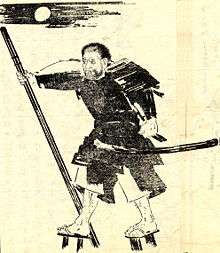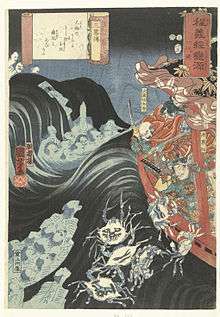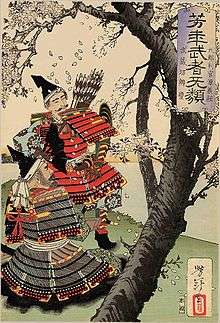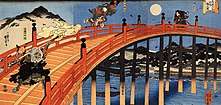Benkei
Saito Musashibō Benkei (武蔵坊弁慶, 1155–1189), popularly called Benkei, was a Japanese warrior monk (sōhei) who lived in the latter years of the Heian Period (794-1185)[1]. Benkei had a varied life, first becoming a monk, then a mountain ascetic, and then a rogue warrior. As he lived, he came to respect and serve the famous warrior Minamoto no Yoshitsune. He is commonly depicted as a man of great strength and loyalty, and a popular subject of Japanese folklore, showcased in many ancient and modern literatures and productions.

Early life

Stories about Benkei's birth vary considerably. One tells how his father was the head of a temple shrine who had raped his mother, the daughter of a blacksmith. Another, sees him as the offspring of a temple god. Many give him the attributes of a demon, a monster child with wild hair and long teeth. In his youth, Benkei may have been called Oniwaka (鬼若)—"demon/ogre child", and there are many famous ukiyo-e works themed on Oniwakamaru and his adventures. He is said to have defeated 200 men in each battle he was personally involved in.

Benkei chose to join the monastic establishment at an early age and traveled widely among the Buddhist monasteries of Japan. During this period, monasteries were not only important centers of administration and culture, but also military powers in their own right, similar to the Roman Legions. Like many other monks, Benkei was likely trained in the use of the naginata, the Half-Moon spear.
At the age of seventeen, Benkei was said to have been 2 meters tall. At this point, he left the monasteries, and became a yamabushi, a member of a sect of mountain ascetics. Benkei was commonly depicted wearing a black cap that was a signature theme of such mountain ascetics.[1]
Seven Famous Weapons
Benkei armed himself with seven weapons, and is often depicted carrying these on his back. In addition to his sword, he carried a broad axe (masakari), a rake (kumade), a sickle (nagigama), a wooden mallet (hizuchi), a saw (nokogiri), an iron staff (tetsubō), and a half-moon spear (naginata).[2]
Career

Benkei is said to have been wandering around Kyoto every night on a personal quest to take 1000 swords from samurai warriors, whom he believed were arrogant and unworthy warriors. After collecting 999 swords through duels and looking for his final prize, he met a young man playing a flute at Gojotenjin Shrine in Kyoto. The much shorter man supposedly carried a gilded sword around his waist. Instead of dueling at the shrine itself, the two walked to Gojo Bridge in the city where the bigger Benkei ultimately lost to the smaller warrior, who happened to be Minamoto no Yoshitsune, a son of Minamoto no Yoshitomo. Not long after the duel, Benkei, frustrated and looking for revenge, waited for Yoshitsune at the Buddhist temple of Kiyomizu, where he lost yet again.[3] Henceforth, he became Yoshitsune's retainer and fought with him in the Genpei War against the Taira clan.[4] Yoshitsune is credited with most of the Minamoto clan's successes against the Taira, especially the final naval battle of Dannoura. After their ultimate triumph, however, Yoshitsune's elder brother Minamoto no Yoritomo turned against him.[5]
From 1185 until his death in 1189, Benkei accompanied Yoshitsune as an outlaw.[6] In the end, they were encircled in the castle of Koromogawa no tate. As Yoshitsune retired to the inner keep of the castle to commit ritual suicide (seppuku) on his own, Benkei stood guard on the bridge in front of the main gate to protect Yoshitsune. It is said that the soldiers were afraid to cross the bridge to confront him, and all that did met swift death at the hands of the gigantic man, who killed in excess of 300 fully trained soldiers.
Death
Realizing that close combat would mean suicide, the warriors following Minamoto no Yoritomo decided to shoot and kill Benkei with arrows instead. Long after the battle should have been over, the soldiers noticed that the arrow-riddled, wound-covered Benkei was still standing. When the soldiers dared to cross the bridge and take a closer look, the giant man fell to the ground, having died standing upright.[7] This is known as the "Standing Death of Benkei" (弁慶の立往生, Benkei no Tachi Ōjō). Benkei died at the age of 34. Atago-do now called Benkei-do holds a statue of Benkei six feet two inches in height at the posture he stood when he died at Koromogawa. It was built in the era of Shotoku (1711-16 A.D.). Replacing an older monument. In olden time the Benkei-do was at the foot of Chusonji hill until it was demolished. The ruins and a single pine tree still remain.[8]
Adaptations
It is Benkei's loyalty and honour which makes him most attractive in Japanese folklore. There is a silent, Black and White movie adaptation of Benkei's story simply titled Benkei (1912)[9]. One kabuki play places Benkei in a moral dilemma, caught between lying and protecting his lord in order to cross a bridge. The critical moment of the drama is its climax, where the monk realises his situation and vows to do what he must. In another play, Benkei even slays his own child to save the daughter of a lord. In the Noh play Ataka, Benkei must beat his own master (disguised as a porter) in order to avoid breaking his disguise. Ataka is later adapted as the kabuki play Kanjinchō, and filmed by Akira Kurosawa as[10]The Men Who Tread on the Tiger's Tail.
Newly Found Story Changes
At the time Benkei was on his own personal quest to collect 1000 swords he had already claimed 999 swords, before meeting his 1000th opponent, Minamoto no Yoshitsune. Many texts state that the scene of the duel took place and Gojo Bridge in Kyoto, but some findings claim it had taken place at Matsubara-Bridge instead.[11]
Notes
- ↑ Yoshikawa, Eiji (1956). The Heike Story: A Modern Translation of the Classic Tale of Love and War. New York: New York: Alfred A. Knopf. ISBN 978-0-8048-1376-1.
- ↑ Ashkenazi, Michael (2003). Handbook of Japanese Mythology. Santa Barbara, CA: ABC-CLIO. pp. 124–125. ISBN 978-1576074671.
- ↑ Matsumoto; Nasu, Kana; Satoko (June 29, 2012). "The Legend of Yoshitsune Minamoto". The Kyoto Project.
- ↑ Kitagawa, Hiroshi et al. (1975). The Tale of the Heike, pp. 535, 540, 654, 656, 669.
- ↑ Sato, Hiroaki (1995). Legends of the Samurai. Overlook Duckworth. p. 144. ISBN 9781590207307.
- ↑ Sansom, George (1958). A History of Japan to 1334. Stanford University Press. p. 317,326. ISBN 978-0804705233.
- ↑ Turnbull, Stephen (1977). The Samurai, A Military History. MacMillan Publishing Co., Inc. p. 83. ISBN 978-0026205405.
- ↑ De Benneville, James S (1910). Saito Musashi-bo Benkei : tales of the wars of the Gempei, being the story of the lives and adventures of Iyo-no-Kami Minamoto Kuro Yoshitsune and Saito Musashi-bo Benkei the warrior monk. Yokohama: Yokohama: J.S. De Benneville. p. 444.
- ↑ Benkei, 1912, retrieved 2018-04-18
- ↑ Kurosawa, Akira (1960-02-28), The Men Who Tread on the Tiger's Tail, Denjirô Ôkôchi, Susumu Fujita, Ken'ichi Enomoto, retrieved 2018-04-18
- ↑ Matsumoto; Nasu, Kana; Satoku (June 29, 2012). "The Legend of Yoshitsune Minamoto". The Kyoto Project. The Kyoto university of Foreign Studies.
References
- Ribner, Susan, Richard Chin and Melanie Gaines Arwin. (1978). The Martial Arts. New York: Harper & Row. ISBN 0-06-024999-4.
- Kitagawa, Hiroshi and Bruce T. Tsuchida. (1975). The Tale of the Heike. Tokyo: University of Tokyo Press. ISBN 0-86008-189-3.
- Yoshikawa, Eiji. (1956). The Heike Story: A Modern Translation of the Classic Tale of Love and War. New York: Alfred A. Knopf. ASIN B0007BR0W8 (cloth).
- _____. (1981). The Heike Story: A Modern Translation of the Classic Tale of Love and War. Tokyo: Tuttle Publishing. ISBN 0-8048-1376-0 (paper).
- _____. (2002). The Heike Story: A Modern Translation of the Classic Tale of Love and War. Tokyo: Tuttle Publishing. ISBN 0-8048-3318-4 (paper).
- (in Japanese) _____. (1989) Yoshikawa Eiji Rekishi Jidai Bunko (Eiji Yoshikawa's Historical Fiction), Vols. 47–62 Shin Heike monogatari (新平家物語). Tokyo: Kodansha. ISBN 4-06-196577-8.
External links
| Wikimedia Commons has media related to Benkei. |
- Grunwald Center for the Graphic Arts, UCLA Hammer Museum: woodcut print -- "Ushiwaka and Benki duelling on Gojo Bridge" or "Gojo Bridge, an episode from the Life of Yoshitsune, Chronicles of Yoshitsune" by Tsukioka Yoshitoshi (1839-1892)